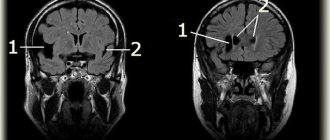Take the first step
make an appointment with a doctor!
Most IVF protocols include a course of hormonal injections to stimulate the ovaries, prepare the woman’s body for embryo implantation, and maintain pregnancy after the procedure. As a rule, injections are performed by a doctor when the patient visits a medical facility or on an outpatient basis. However, this is not always convenient or possible - for example, if the woman works or is far from the clinic. Such injections can be performed independently, but the patient must clearly understand how to give injections during IVF so that they are as effective and safe as possible.
What is human chorionic gonadotropin?
The abbreviation hCG stands for human chorionic gonadotropin. Its structure is a combination of alpha and beta units. Alpha is similar in structure to TSH and FSH, but beta is unique and it is the one that affects the pregnancy rate during the test.
Beta units are produced early in pregnancy, up to the 10th week. At week 11, their number increases sharply, and this growth indicates the active development of the embryo and the normal course of pregnancy. Then the indicators stop increasing and remain stable until the baby is born. Focusing on the level of the hormone, the increase and decrease in its volume, doctors make assumptions and conclusions about the health and activity of the fetus, the presence or absence of pathologies and anomalies, as well as the general course of pregnancy.
A pregnant woman should undergo examinations that show not only the level of hCG, but also the body’s synthesis of antibodies that oppose the hormone. They interfere with the normal functioning of the protein and lower the level of placental hormones. A normal level of hCG favors the preservation of the fetus and dulls the body’s immune functions, excluding rejection. An analysis for the beta component can be prescribed to a non-pregnant woman and even a man for a preliminary assessment of the presence of hormone-dependent tumors.
Monitoring of hCG levels is carried out through regular examinations with comments from the leading physician, as well as through independent comparison of the results with the hCG table.
Reasons for the development of anovulation
The reasons that provoke the development of anovulation can be physiological and pathological (chronic). Physiological anovulation is considered normal, does not require seeking medical help and can occur during the following periods in a woman’s life:
• puberty: in teenage girls, ovulation may not occur for the first two years after menarche; • period of pregnancy and breastfeeding; • menopause; • “rest” period: 1-2 menstrual cycles per year; women of reproductive age may not ovulate.
Pathological anovulation can be caused by a violation of the structure of organs or diseases of the endocrine system. Most often, the presence of this particular condition is the cause of infertility.
Pathological reasons for the lack of ovulation may be the presence of the following conditions:
• dysfunction of the hypothalamus; • oncological diseases of the pituitary gland; • circulatory disorders in the brain; • hyperprolactinemia; • hyperandrogenism; • frequent stress; • injuries of the reproductive system; • inflammatory diseases of the appendages; • obesity; • anorexia; • premature menopause; • gynecological diseases (polycystic ovary syndrome, endometriosis, uterine fibroids, etc.); • diseases of the thyroid gland and liver; • when taking hormonal contraceptives.
In what cases is a hCG injection recommended?
Doctors advise resorting to injections of the hormone after receiving test results for its levels. Typically, the introduction of effective drugs is recommended in the following cases:
- Dysmenorrhea,
- Problems with the ovaries
- Disadvantages of the ovulation process,
- Problems associated with the corpus luteum
- The prospect of miscarriage
- Inability of the body to bear a child,
- Therapy before in vitro fertilization,
- Formation of placental tissue.
Medicines containing hCG are used for reproductive procedures of various specifics, since the hormone has a positive effect on the functioning of the ovaries.
Injection technique
The drug is injected into the subcutaneous tissue.
After all preparatory procedures have been completed, you can begin giving the injection. To achieve the desired result, you must follow simple rules:
- The required amount of medicine is drawn into a syringe. For products in a syringe pen, the dosage is selected directly on the tube itself.
- The syringe must be held like a dart.
- With the other hand, take a fold of skin and grab the subcutaneous fatty tissue. Do not inject the drug into a red or bruised area.
- The corner is quickly and confidently immersed into the skin at a 90-degree angle. Awkward movements can lead to painful sensations.
- After the needle has completely penetrated the skin, the medicine is injected.
- Carefully remove the syringe. The injection site is wiped with a sterile cloth.
It is important to dispose of used consumables correctly. To do this, use a special hard container or glass jar with a lid.
Carrying out an HCG injection
Intramuscular administration of the drug involves the possibility of self-injection, if the woman has the necessary experience and knowledge, but can also be carried out in a medical institution. You can also call a nurse to your home. It is worth taking into account that hCG injections are carried out in a course, so it is worth preparing for therapy in advance.
The hCG injection is given in the stomach. For many women, this is a frightening fact, since many are accustomed to injections into the buttock and do not really understand the meaning of such prescriptions. An injection in the stomach is more effective. To carry it out, measure a distance of two fingers from the navel to the left or right. Then, using your fingers, the skin of the abdomen is collected into a small fold and a needle is inserted into it. It does not penetrate the skin completely. The most relevant tool will be an insulin needle, which is used for injections for diabetes. The needle must first be sterilized in an alcohol solution.
The dosages of drugs recommended for injection may vary depending on medical prescriptions and the individual situation. The most popular dosages of the substance that can be purchased at the pharmacy are standards of 500, 1,000, 1,500, 5,000 and 10,000 units.
Depending on the indications, different numbers of hCG injections may be recommended, aimed at creating the necessary conditions for pregnancy. The standard dose of the drug for each use is considered to be 5-10 thousand units. Assessing the change in the situation, the doctor may prescribe a lower dose after several injections. When carrying out hormonal therapy, the size of the follicles is taken into account so as not to motivate excessive stimulation of the ovaries.
The main indication for hCG injection is diagnosed infertility. Some time after hormonal therapy, an ultrasound is performed, which makes it possible to clarify the presence of positive changes. If expectations are met, an hCG injection is given to stimulate ovulation. The positive effect of the hormone also lies in the fact that it does not give the follicles the opportunity to regress.
When stimulating superovulation as part of the reproductive program, the patient is administered a single dose of about 10 thousand units of human chorionic gonadotropin, which ensures the growth of several follicles at once, which will subsequently become eggs. 36 hours after the injection, you can select an egg that best meets the requirements for artificial conception.
If doctors diagnose a threat of miscarriage, the maximum dose is administered through an hCG injection, and then 5 thousand units of the hormone are injected twice a week. In order for hormonal therapy to remain relevant and effective, it must begin before the eighth week of pregnancy, and its end should be scheduled closer to the 14th week of pregnancy.
Preparing for injections during IVF
Injections within the framework of in vitro fertilization are carried out subcutaneously or intramuscularly. Both methods simplify the procedure and make it safer, since there is no need to insert the needle directly into the vein. However, such injections also require preparation and certain knowledge.
Subcutaneous injections are made to certain places on the body where there is a sufficient layer of fatty tissue:
- the triceps (extensor muscle) area on the side and back of the arm, located between the elbow and shoulder;
- the lateral side of the thigh, closer to its outer part (in the area of the quadriceps muscle);
- the thick part of the abdominal area located below the ribs but above the hips and not directly next to the umbilical cord.
For each injection, new needle entry points must be selected (within the specified areas). If injections are made into the same place, then due to tissue trauma, an inflammatory focus will appear in it, which can either become infected or become very dense due to scarring.
Before giving injections for IVF, you need to buy medications prescribed by your doctor. Today they come in convenient disposable syringe capsules or reusable syringes with replaceable needles. In addition, for safe injections you need:
- container for safe disposal of needles and used doses of the drug;
- alcohol or other disinfecting liquid (gel, injection wipes);
- sterile gauze pad (usually 2 x 2 cm);
- clean towel (napkin).
Take the first step
make an appointment with a doctor!
If the fertility specialist prescribed injections of only half the bottle, the remaining part of the drug should be stored in the refrigerator in a tightly closed container.
Recommendations for pregnant women
An injection of hCG is recommended for a pregnant woman when her body does not have enough human chorionic gonadotropin for a comfortable pregnancy and the development of a healthy fetus. Before giving instructions on the need for hormonal therapy, the doctor asks for a repeat test for hormone levels and draws conclusions based on several studies.
The hCG norm is a vague concept, so you should not be afraid of minor deviations down or up. But when your test results differ from the standards indicated in the hCG table, you need to carry out hormonal therapy and identify the reasons for the deviation from the norm.
Non-compliance with standards can be caused by various pathologies and anomalies, including:
- Ectopic pregnancy,
- Frozen pregnancy
- Problems in the formation of the placenta,
- Risk of miscarriage.
When resorting to hormonal therapy, do not forget about the possible side effects that the use of drugs can lead to. The use of human chorionic gonadotropin can be fraught with the formation of a follicular cyst and other pathologies. Preparations containing hCG are not recommended for use for the following reasons:
- During lactation,
- With early menopause,
- In case of tumors in the ovaries and pituitary gland,
- With thrombophlebitis,
- In case of obstruction of the fallopian tubes,
- If you have allergies.
If a married couple is faced with the impossibility of conceiving on their own, reproductive specialists find out what the cause of the problem is by analyzing the results of tests and examinations that both partners undergo. If a deficiency of human chorionic gonadotropin is confirmed, an hCG injection is indicated. Correctly calculated effects of hormonal therapy help to successfully carry out artificial insemination, comfortably carry and give birth to a healthy baby.
Who is suitable for stimulation?
Ovulation induction is prescribed if:
- The woman has a reduced ovarian reserve.
- The patient is over 35 years old.
- It is necessary to obtain a large number of oocytes.
- Menstrual function is disrupted (natural cycle is too long or short).
- Hypo- or hyperestrogenism has been established, and the quality of the endometrium has been reduced.
- The patient does not ovulate in the natural cycle (or occurs, but late).
- The follicles do not grow on their own (for example, due to the fact that the woman has previously had ovarian surgery).
- The implantation window does not open due to an imbalance of estrogen and progesterone.
- There have been previous failed protocols in natural cycles.











